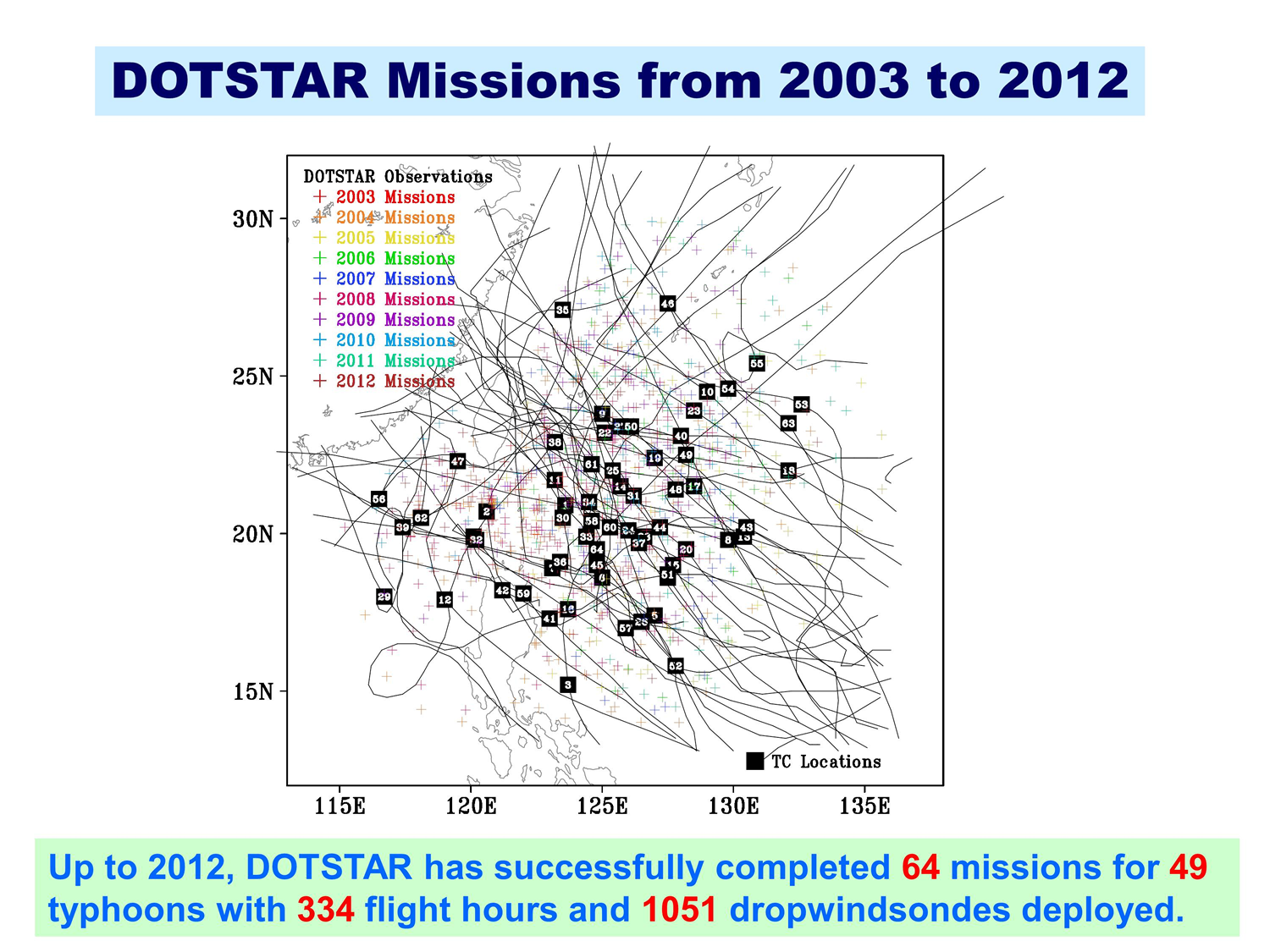Updated Summary of Progress
The DOTSTAR (Dropsonde Observations for Typhoon Surveillance near the Taiwan Region) is an international research program conducted by scientists in Taiwan, partnered with scientists at the Hurricane Research Division (HRD) and the National Centers for Environmental Prediction (NCEP) of the National Oceanic and Atmospheric Administration (NOAA), Meteorological Research Institute/Japan Meteorological Agency (MRI/JMA), and Naval Research laboratory. This project marks the beginning of a new era for the aircraft surveillance of typhoons in the western North Pacific.
Built upon work pioneered at NOAA's HRD, the key to the project is the use of airborne sensors -- dropwindsondes, which are released from jet aircraft flying above 42,000 feet in the environment of a tropical cyclone. These sensors gather temperature, humidity, pressure, and wind velocity information as they fall to the surface. Information from the surveillance flights is transmitted in near real-time to the CWB of Taiwan, as well as to the NCEP, FNMOC, and JMA. The data are immediately assimilated into the numerical models of CWB, NCEP (AVN/GFDL), FNMOC (NOGAPS/COAMPS/GFDN), UKMET, and JMA. The DOTSTAR are expected to provide valuable data which can help increase the accuracy of TC analysis and track forecasts, to assess the impact of the data on numerical models, to evaluate the strategies for adaptive/targeted observations, to validate/calibrate the remote-sensing data, and to improve our understanding on the TC dynamics, especially over the TC’s boundary layer (Wu et al. 2005, BAMS).
On September 1, 2003, the first DOTSTAR mission was successfully completed around Typhoon Dujuan. NOAA remarked upon the successful collaboration in a press release. On November 2, the second mission was launched while the aircraft flew over the center of Typhoon Melor. Ten more flights have been conducted for Typhoons Nida, Conson, Mindulle, Megi, Aere, Meari, Nock-Ten and Namadel in 2004, with 193 dropsondes released. An average 20% improvement for the 12-72h track forecasts over the NCEP-GFS, FNMOC-NOGAPS, JMA-GSM, their ensembles, and the WRF model has been demonstrated (Wu et al. 2007, Wea. Fcsting). Seven flights have been conducted for Typhoons Haitang, Matsa, Sanvu, Khanun, and Longwang in 2005, five flights for Bilis, Kaemi, Bopha, Saomai, and Shanshan in 2006, four flights for Pabuk, Sepat, Wipha, and Krosa in 2007, and ten flights for Fengshen, Kalmaegi, Fung-wong, Nuri, Sinlaku, Hagupit, and Jangmi in 2008, and seven flights for Linfa, Morakot, Parma and Lupit in 2009, and six flights for Compasu, Lionrock, Fanapi,and Megi in 2010, and four flights for Meari, Muifa, and Roke in 2011, and six flights for Talim, Doksuri, Saola, Kai-Tak, Tembin, Bolaven, and Jelawat in 2012. In total, the DOTSTAR have conducted 64 surveillance flight missions for 49 typhoons, with 334 flight hours and 1051 dropsondes released. DOTSTAR also played a part in some international field experiments, including T-PARC(THORPEX/PARC; The Observation System Research and Predictability Experiment Pacific-Asian Regional Campaign, T-PARC) in 2008 and ITOP(Impact of Typhoons on the Ocean in the Pacific) in 2010. In this year, abundant data just have been collected by ASTRA (DOTSTAR), C130 aircraft (US Air Force), in addition with numerous buoy and ship observations during the lifetime of Typhoon Fanapi and Megi.

Multiple techniques have been used to help design the flight path for the targeted observations in DOTSTAR:
- The area with the largest forecast deep-layer-mean wind bred vectors from the NCEP Global Ensemble Forecasting System at the observation time. (Aberson 2003)
- The Ensemble Transform Kalman Filter, which predicts the reduction in forecast error variance for all feasible deployments of targeted observations. (Majumdar et al. 2002)
- The NOGAPS singular vectors that identify sensitive regions. (Peng and Reynolds 2006)
Recently we have proposed a new theory (Wu et al. 2007, JAS) to identify the sensitive area for the targeted observations of tropical cyclones based on the adjoint model. By appropriately defining the response functions to represent typhoon’s steering flow at the verifying time, a unique new parameter, the Adjoint-Derived Sensitivity Steering Vector (ADSSV) has been designed to clearly demonstrate the sensitivity locations at the observing time. The ADSSV are being implemented and examined in DOTSTAR, as well as the hurricane surveillance program of NOAA’s Hurricane Research Division in the Atlantic in 2005 (Etherton et al. 2006, 27th Conf. on Hurr.). An inter-comparison study (Wu et al. 2009, MWR) had been conducted to examine the common feature and difference among all the different targeting techniques. Meanwhile, some better methods to combine the dropwindsonde data with the bogused vortex has also been examined in Chou and Wu (2007, MWR). Overall, the DOTSTAR has made significant impact to the typhoon research and operation community in the international arena.
As the DOTSTAR research team continues to harvest important data and gain valuable experience, we believe that future typhoon observations will reach full maturity, enabling significant progress in both academic research and typhoon forecasting. It is hoped that DOTSTAR will shed light on typhoon dynamics, improve the understanding and predictability of typhoon track through the targeted observations, place the team at the forefront of international typhoon research, and make a significant contribution to the study of typhoons in the northwestern Pacific and East Asia region. A special collection (issue) on “Targeted Observation and Data Assimilation for Improving Tropical Cyclone Predictability” led by Chun-Chieh Wu has been published in the Monthly Weather Review in 2009.